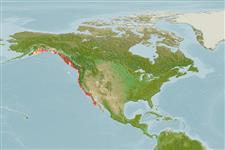>
Perciformes/Scorpaenoidei (Scorpionfishes) >
Sebastidae (Rockfishes, rockcods and thornyheads) > Sebastinae
Etymology: Sebastes: Greek, sebastes = august, venerable (Ref. 45335); auriculatus: From the Latin auriculatus, meaning 'eared' (Ref. 27436).
More on author: Girard.
Environment: milieu / climate zone / depth range / distribution range
ນິເວດວິທະຍາ
ສັດທະເລ ອາໄສຢູ່ໃກ້ໜ້າດິນໃຕ້ພື້ນທ້ອງນ້ຳ; ລະດັບຄວາມເລິກ 0 - 128 m (Ref. 27437). Temperate; ? - 15°C (Ref. 131058); 62°N - 27°N, 155°W - 113°W
Eastern Pacific: Prince William Sound, Alaska to central Baja California, Mexico.
Length at first maturity / ຂະໜາດ / ນ້ຳໜັກ / Age
Maturity: Lm 31.0, range 26 - 38 cm
Max length : 56.0 cm TL ຕົວຜູ້/ບໍ່ມີເພດ; (Ref. 27437); ອາຍຸສູງສຸດທີ່ເຄຍລາຍງານມາ: 34 ປີ (Ref. 56049)
ຄີ (ໜາມ)ແຂງຢູ່ຫຼັງປາ (ທັງໝົດ) : 13; ຄີຫຼັງຂອງປາ (ຄີອ່ອນ) (ທັງໝົດ) : 12 - 15; ຄີ(ໜາມ) ແຂງຢູ່ຄີກົ້ນປາ
ກຸ່ມປາກະດູກແຂງ
ຄວາມຖີ່ຂອງກຸ່ມຖ່າຍທອດພັນ
ປາທີ່ມີການເຄື່ອນຍ້າຍຈາກທະເລໄປຫານ້ຳຈືດ ແລະນ້ຳຈືດຫາທະເລ
ປາທີ່ມີການເຄື່ອນຍ້າຍຈາກທະເລແລະໄປໄຂ່ຢູ່ນ້ຳຈືດ
ຄີກົ້ນຂອງປາ
ສັດທີ່ມີກະດູກສັນຫັຼງ
ການຖ່າຍທອດທາງກຳມະພັນຈາກພໍ່ແມ່ຫາລູກ: 3; ຄີກົ້ນຂອງປາ: 5 - 8; ສັດທີ່ມີກະດູກສັນຫຼັງ: 26 - 27. Head spines strong - nasal, preocular, postocular, tympanic, coronal (may be absent), parietal, and nuchal (may be absent) spines present, supraoculars absent (Ref. 27437). Interorbital space flat to barely convex; symphyseal knob weak or absent (Ref. 27437). Caudal fin rounded (Ref. 6885). Light brown, mottled with one or two shades of darker brown, vague dark bars dorsally, dark brown blotch on upper part of gill cover; fins and underside of throat and lower jaw pinkish (Ref. 27437). Branchiostegal rays: 7 (Ref. 36715).
A sedentary rockfish found in shallow water and bays (Ref. 2850), among sheltering weed-covered rocks or around pilings (Ref. 27436). Viviparous, with planktonic larvae and pelagic juveniles (Ref. 36715). Fin spines are sharp and mildly venomous and can cause annoying wounds (Ref. 27436). Small live specimens make excellent bait for large lingcod (Ref. 27436). Flesh is firm and tasty, but rarely found in markets (Ref. 26346).
Eschmeyer, W.N., E.S. Herald and H. Hammann, 1983. A field guide to Pacific coast fishes of North America. Boston (MA, USA): Houghton Mifflin Company. xii+336 p. (Ref. 2850)
IUCN Red List Status (Ref. 130435: Version 2024-1)
Human uses
ການປະມົງ: ທີ່ເປັນການຄ້າໜ້ອຍ; ຊະນິດປາທີ່ຖືກນຳໃຊ້ເຂົ້າໃນການຫາເພື່ອເປັນເກມກິລາ: ແມ່ນ; ຕູ້ປາ: ບ່ອນວາງສະແດງສັນນ້ຳຂອງລັດ; ເຍື່ອ: occasionally
ເຄື່ອງມື
Special reports
Download XML
ແຫຼ່ງອີນເຕີເນັດ
Estimates based on models
Preferred temperature (Ref.
123201): 8 - 12.8, mean 9.7 °C (based on 80 cells).
Phylogenetic diversity index (Ref.
82804): PD
50 = 0.5000 [Uniqueness, from 0.5 = low to 2.0 = high].
Bayesian length-weight: a=0.01000 (0.00495 - 0.02022), b=3.09 (2.92 - 3.26), in cm total length, based on LWR estimates for this Genus-body shape (Ref.
93245).
ຊັ້ນເຂດຮ້ອນ (Ref.
69278): 4.0 ±0.62 se; based on food items.
ຄວາມຢືດຢຸ່ນ (Ref.
120179): ຕຳ່, ປະຊາກອນຕຳ່ສຸດທີ່ໃຊ້ເວລາສອງເທົ່າ 4.5 - 14 ປີ (tmax=34; tm=5).
Prior r = 0.19, 95% CL = 0.13 - 0.29, Based on 2 full stock assessments.
Fishing Vulnerability (Ref.
59153): Moderate vulnerability (42 of 100).
Nutrients (Ref.
124155): Calcium = 23.4 [8.7, 72.9] mg/100g; Iron = 0.241 [0.100, 0.565] mg/100g; Protein = 18.2 [17.0, 19.3] %; Omega3 = 1.14 [0.47, 2.78] g/100g; Selenium = 31.1 [12.4, 94.1] μg/100g; VitaminA = 24.2 [7.7, 76.5] μg/100g; Zinc = 0.356 [0.189, 0.635] mg/100g (wet weight);
